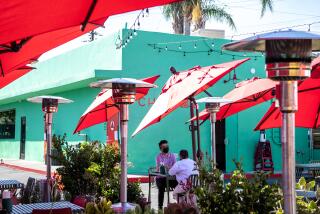Roadblock Ahead? : Cities Are Imposing More Restrictions on Drive-Through Restaurants
- Share via
Despite their big smiles, these are nervous times for Ronald and Jack. Carl Jr. is getting a little edgy, too.
Cars may be king in Southern California but local governments are slamming the brakes on drive-through fast-food restaurants after growing numbers of complaints by neighbors about noise and traffic.
From the 1960s, they defined the regional landscape, spreading nationwide. Now drive-through fast-food restaurants are joining strip malls and landfills in being cast as the land use pariahs of the 1990s.
The city of Sierra Madre this year banned drive-through restaurants. Last year, Burbank banned fast-food restaurants from operating drive-through windows 24 hours a day. Officials in South Pasadena and Newport Beach have imposed temporary bans while they draft tougher drive-through restrictions. And Los Angeles is starting to charge higher permit fees to new outlets to pay for traffic improvements.
Several other Southern California cities have begun restricting the hours that restaurants can operate drive-through windows, a trend industry representatives worry may begin to spread to cities around the country.
Even the state’s Air Resources Board has taken a shot at the ubiquitous drive-through, saying that cars idling in line contribute to Southern California air pollution.
Drive-through restaurants are largely victims of their own success. Some of the country’s fast-food giants--McDonald’s, Burger King and Wendy’s--scored record sales this year, with franchises being added at a growth rate as high as 14% a year.
Profits from fast-food outlets nationwide are expected to surpass traditional restaurants for the first time this year.
For a $100-billion-a-year industry that earns nearly half of its profits from drive-through windows, the restrictions and bans clearly worry industry leaders.
“This is not a good trend,” said Stan Kyker, executive vice president of the California Restaurant Assn.
Kyker and other fast-food industry representatives--who prefer the label “quick service restaurants”--say drive-throughs simply serve motorists already traveling on nearby roads, and therefore do not create traffic problems.
Planning and transportation experts seem to agree.
Although there are few studies on the subject, George Lefcoe, a USC land use and real estate professor, said most drive-through customers stop at the restaurants on the way to another destination. The restaurants, he said, should not be blamed for the traffic that they serve.
“If cities want to get rid of these businesses, they are kissing goodbye to an awful lot of money and keeping a lot of traffic,” Lefcoe said.
Restaurant industry groups also dispute a long-standing belief by air quality officials that idling cars lined up at drive-through windows contribute to Southern California’s smog problem.
Ten fast-food restaurants chains paid for a study several years ago that concluded that customers of walk-up restaurants contribute more to the smog problem by stopping and starting cars in the parking lot than motorists idling in the drive-through line.
Jerry Martin, a spokesman for the state Air Resources Board, acknowledged that engines spew more emissions when they are started cold than when a warm engine is idling. But he said that a car idling at a drive-through window line for 10 to 15 minutes creates about as much pollution.
“It has been fairly clear that if you are going to sit in a line at a drive-through restaurant for more than a few minutes, it’s better to park the car and go in to make your purchase,” he said.
But it’s not the car exhaust that rankles neighbors. The most common complaints are over teenage loitering, trash and the noise from the loudspeakers that customers use to order their food.
Those troubles prompted Burbank to require restaurants to close their drive-through windows by midnight, said Carolyn Berlin, a former homeowner leader and member of the Burbank Planning Board.
The city of Thousand Oaks in Ventura County rejected three requests in four years by McDonald’s to build a drive-through restaurant in the Oakbrook Plaza shopping center, citing concerns about traffic and litter.
The moratorium in Newport Beach was imposed for a stretch of Pacific Coast Highway while a committee drafts a redevelopment plan for the area, known as Mariners Mile.
In South Pasadena, which has one drive-through restaurant, the City Council voted last week to extend a yearlong moratorium on any more. Residents say they believe too many of the restaurants would erode their community’s small-town character.
Several customers at the South Pasadena McDonald’s said they understand the concern about traffic problems but would hate to be without the convenience of their local drive-through window.
“The drive-though makes it a lot easier with kids because you don’t have to drag them in and out of the restaurant,” said Maureen Delacruz, who waited in line with her son, Michael, squirming in the passenger seat.
She was joined by a long line of lunchtime customers Friday, including other mothers ferrying their preschool and kindergarten-age children through the drive-through line for a quick meal.
Delia Sandoval, who was buying her grandson a Big Mac, said she has no problem with South Pasadena’s moratorium “as long as they don’t get rid of them in Alhambra,” where she lives. “We need them there,” she said.
In cities where the protest over drive-throughs has been loudest, planning officials have imposed limits on hours of operation.
Restaurant owners are complaining that it is unfair to impose restrictions after a business has been approved and investments have been made. The industry backed state legislation last year to prohibit restrictions on established restaurants. The legislation failed but Kyker said his association will try again.
In Sierra Madre, the ban on drive-through windows was motivated by efforts to retain an old-fashioned, pedestrian-friendly atmosphere in the small San Gabriel Valley community.
As in other cities, many Sierra Madre residents worried that drive-through restaurants could be a magnet for gangs, graffiti and panhandlers, a concern that restaurant representatives reject.
In Los Angeles, drive-through restaurants can be built near residential neighborhoods but only after public hearings.
“We usually tell businesses to talk to the community first before applying,” said Deputy Planning Director Frank Eberhard. “Not that they are not still controversial, because they are.”
Although the restrictions on drive-through restaurants appear to be limited to Southern California, fast-food chains worry that the trend may spread to the rest of the country.
“Burger King is closely monitoring what is happening in several Southern California communities to restrict the use of drive-through lanes,” said Kim Miller, a company spokesperson.
Restaurant owners say they are responding to neighborhood concerns, either by providing security or designing restaurants in a way that reduces noise and loitering.
“Our philosophy is to work cooperatively with the municipalities and the neighbors in the communities,” said Amy Sherwood, a spokesperson for Taco Bell. “But drive-through windows provide a convenience for our customers and we will continue to provide that convenience as we build more restaurants.”
Some restaurant chains have shown a willingness to bend on the issue.
McDonald’s voluntarily removed the drive-through window on a proposed franchise in Granada Hills at the request of Los Angeles City Councilman Hal Bernson, who heads the city’s Planning and Land Use Committee.
Bernson, who prides himself on being pro-business, said the problems associated with drive-through restaurants are likely to prompt more restrictions.
“I think restaurants that have drive-through windows are going to have to prove in the future that they are not going to be a problem,” he said.
More to Read
Inside the business of entertainment
The Wide Shot brings you news, analysis and insights on everything from streaming wars to production — and what it all means for the future.
You may occasionally receive promotional content from the Los Angeles Times.











